
Over the next few weeks we are going to be doing a series about things you think you know about hazardous waste (that are actually wrong). These posts have been contributed by our 10-year Heritage Compliance Manager, Mike Karpinski. So without further ado, our first common misconception:
All hazardous wastes are “hazardous”
One of the key thoughts we try to convey in employee safety training at Heritage Environmental Services, LLC is the fact that the terms “hazardous waste” and “non-hazardous waste” are simply regulatory terms. There are many stipulations in the regulations that can classify a very dangerous chemical as a non-hazardous waste and a relatively benign waste a hazardous waste.
For example, there is a part of the EPA hazardous waste regulation commonly called the “mixture rule” for listed hazardous wastes that essentially states “the mixture of any listed hazardous waste with any other solid waste will result in the entire mixture being a listed hazardous waste.”
Reasoning by analogy, this means that if you take a swimming pool of water and add a thimble full of a listed hazardous waste you have created a swimming pool of listed hazardous waste. The swimming pool is probably still very safe to swim in but the water is a listed hazardous waste nonetheless (The swim suit you used for your dip in the pool and the water you used to shower off with after your dip will also be listed hazardous wastes until properly disposed of at a permitted hazardous waste treatment/disposal facility).
Some other common materials that may qualify as hazardous wastes include:
– Nicotine Patches
– Finger Nail Polish
– Hand Sanitizers
– Mosquito Spray
– Silly String
– Windex/Formula 409
– Teeth Whitening Strips
– Pool chemicals
– Gasoline
– Oil based paint
– Rechargeable Batteries
– Fluorescent Lighting
But don’t worry; men in dark suits are not on their way to take you away if you have thrown any of these things out at your home. Households are excluded from the hazardous waste regulations. If you are a business disposing things like these though you should probably stop and call a company like Heritage to help you manage these materials properly.
More News From Heritage
-
Published Articles 8/2/22
How Safety, Maintenance, and Reliability Are Intertwined
VP of Health and Safety Jim Mangas discusses the importance of plant safety, maintenance, and reliability (featured in BIC Magazine July/Aug '22)
-
Blogs 7/28/22
Spotlighting Our Environmental Interns
Highlighting some of the wonderful interns we have at Heritage this year!
-
Blogs 7/11/22
Turning Hazardous Waste into an Alternative Fuel
In this blog we walk you through the process of fuel blending, where we can turn hazardous waste materials into a viable alternative fuel source.
-
Community News 6/15/22
2022 Habitat for Humanity Build
Our 12th annual Habitat for Humanity Build
-
Blogs 4/13/22
After Hurricane Ida, Our Port Fourchon Office Rebuilds
On August 28th, 2021, the Louisiana coast was battered by Hurricane Ida. This included our Port Fourchon Service Center, where the devastating hurrica
-
Community News 4/7/22
Heritage readies for Earth Day HHW collection in East Liverpool
Heritage Thermal Services is pleased to announce that its collection of household hazardous wastes for the East Liverpool area returns for 2022.
-
Published Articles 4/2/22
The Impact of Changing Conditions
VP of Health and Safety Jim Mangas discusses preparedness for unexpected conditions during a project. (featured in BIC Magazine March/April '22)
-
Blogs 3/11/22
International Women’s Week Spotlight – Rachel McGrogan
Rachel McGrogan speaks about her time as a Lab Chemist at Heritage.








